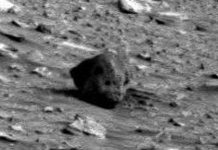 Researchers in the United Kingdom have found algae-like fossils in meteorite fragments that landed in Sri Lanka last year. This is the strongest evidence yet of cometary panspermia — that life on Earth began when a meteorite containing simple organisms landed here, billions of years ago — and, perhaps more importantly, that there’s life elsewhere in the universe.
Researchers in the United Kingdom have found algae-like fossils in meteorite fragments that landed in Sri Lanka last year. This is the strongest evidence yet of cometary panspermia — that life on Earth began when a meteorite containing simple organisms landed here, billions of years ago — and, perhaps more importantly, that there’s life elsewhere in the universe.
In December 2012, a fireball was seen over the skies of Polonnaruwa, Sri Lanka. Over the following few days, fragments of the fireball were collected and sent to Sri Lanka’s Medical Research Institute, where initial microscopic analysis revealed siliceous microalgae known as diatoms. As you can imagine, with this being the first ever evidence that life might’ve arrived on Earth via a meteorite, the scientific community was skeptical of the results — and so some fragments were sent to Cardiff University in Wales for further analysis. The researchers at Cardiff are now reporting that they’re sure that these fragments come from an extraterrestrial meteorite — and that there are definitely “fossilized biological structures” within them. Panspermia, it seems, is a go.
There are a few competing theories for how life began on Earth. Panspermia, where life arrived on the back of a comet or asteroid, is one. Abiogenesis, the theory that life spontaneously erupted from inorganic molecules in Earth’s primordial soup, is another. Directed panspermia, where an alien race intentionally sent an asteroid or spacecraft loaded with living organisms to Earth, is another slightly more exotic theory. As for which theory is correct, we’ll probably never know — but the Polonnaruwa meteorite definitely puts the odds in panspermia’s favor.

Cardiff University’s tests took a two-pronged approach: First to confirm that there were actually algae fossils within, but more importantly to rule out terrestrial contamination. To this end, the researchers found very low levels of nitrogen (which is nearly always present in modern-Earth organisms), and their oxygen isotope analysis “shows [that the samples] are unequivocally meteorites.” The meteorite’s atomic makeup, coupled with the fossils being fused with the rock matrix, is a strong indicator that the organisms aren’t terrestrial in origin.
Read More: Source extremetech.com

![mars-comet[1]](https://coolinterestingnews.com/wp-content/uploads/2013/03/mars-comet1-1.jpg)












